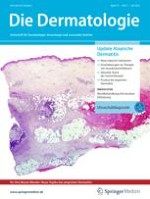Erschienen in:

01.03.2004 | Übersicht
Sauerstoffversorgung der Haut
Unter besonderer Berücksichtigung der kutanen Sauerstoffaufnahme aus der Atmosphäre
verfasst von:
Priv.-Doz. Dr. M. Stücker, C. Moll, P. Altmeyer
Erschienen in:
Die Dermatologie
|
Ausgabe 3/2004
Einloggen, um Zugang zu erhalten
Zusammenfassung
Sauerstoff diffundiert sowohl aus dem Blut als auch aus der Atmosphäre in die Haut. Für den Sauerstofftransport sind Diffusionsgradienten von entscheidender Bedeutung. Messungen mit Einstichelektroden zeigen ein Maximum des Sauerstoffpartialdrucks an der Hautoberfläche und ein Minimum im Korium deutlich unterhalb der Epidermis. Nichtinvasive Messungen der Sauerstoffaufnahme aus der Atmosphäre zeigen eine lokalisationsabhängige Sauerstoffaufnahme. Bei einem Sauerstoffverbrauch von 0,276±0,029 ml O2·100 g−1·min−1 ergibt sich unter der Voraussetzung, dass kein Sauerstoff über die Kapillaren abtransportiert wird, dass die Haut bis in das Korium durch atmosphärischen Sauerstoff versorgt wird. Nur das tiefere Korium bezieht Sauerstoff aus dem Blut. Eine wesentliche Barriere der Sauerstoffdiffusion aus der Atmosphäre stellt das Stratum corneum dar. Wird diese Barrierefunktion gestört, steigt die Sauerstoffdiffusion in die Haut an. Da Keratinozyten in der Zellkultur durch eine Steigerung des Sauerstoffpartialdrucks vermehrt proliferieren, könnte auch in vivo die Epidermishyperplasie nach Störung des Stratum corneum durch eine gesteigerte Sauerstoffzufuhr aus der Atmosphäre erklärt werden.